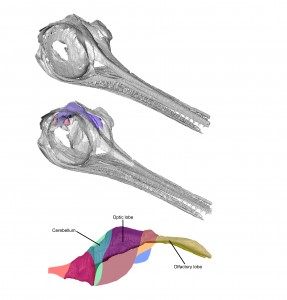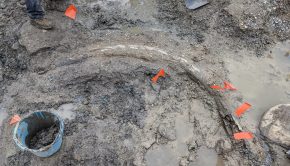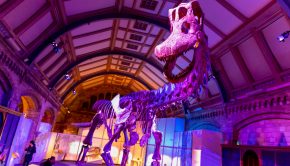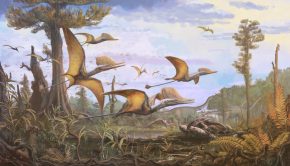Published on June 12th, 2015 | by Liz Martin-Silverstone
Ichthyosaur skull reconstruction
A new study out today has produced the world’s first ichthyosaur endocast, which can tell us a lot more about how these ancient marine reptiles were adapted for life in the oceans.
Ryan Marek from the University of Bristol, lead author on the study had this to say: “Ichthyosaurs were a group of marine reptiles that occupied the world’s oceans from the Early Triassic to the Late Cretaceous, and they’ve been known to science for over 200 years. In this time, palaeontologists have found some really fantastic ichthyosaur fossils, such as whole body fossils showing soft tissue outlines. There are even examples of ichthyosaurs giving birth to live young as far back as 248 million years ago! However, the ichthyosaur fossil record has one major caveat, most specimens are laterally compressed, almost two-dimensional in the worst cases. This limits the study of these creatures, as some of the latest techniques that employ CT scanning and digital reconstructions, which have previously allowed palaeontologists to understand cranial biomechanics and neuroanatomy of dinosaurs, cannot be used because the fossils are just too compressed.
Fortunately, Bath Museum had a fantastic, fully three-dimensional skull of Hauffiopteryx typicus, a species of ichthyosaur found around Bristol and in parts of Germany from the Toarcian (Early Jurassic). By scanning the skull of Hauffiopteryx with a CT scanner, we could reconstruct and repair it using digital software. When this was complete, we noticed that the area where the brain would sit inside the skull was almost untouched by compression. We then made an endocast, a 3D internal cast of the skull, which gave us a representation of what the brain of this ichthyosaur would have looked like. With this endocast, we can see what senses the brain of Hauffiopteryx may have been best adapted to process. In the case of Hauffiopteryx, the brain was best adapted to process visual cues, with large optic lobes. This is unsurprising as ichthyosaurs have such large eyes. The cerebellum, the area of the brain that controls motor coordination is also enlarged. Again this is expected, as other agile, fast moving ocean predators such as dolphins have enlarged cerebellums. Rather unexpected however, is the enlargement of the olfactory lobe, meaning that Hauffiopteryx had a good sense of smell. Putting all of this information together, and we can see that ichthyosaurs such as Hauffiopteryx, even by the Early Jurassic had adept neuroanatomical adaptations to life in the oceans, allowing them to be agile ocean hunters, with sharp visual acuity and a keen sense of smell.”
Coauthor Benjamin Moon said: “Not only does this study provide us with a three-dimensional representation of the brain of ichthyosaur for the first time, it allows us to study the internal anatomy with great detail, which was previously difficult due to the flattened nature of most ichthyosaur skull”.
Another coauthor, Professor Mike Benton said: “The fossil itself is spectacular, but was discovered a long time ago, and so has been sitting in the depths of the Bath Museum for many years now. Hopefully this study will motivate other palaeontologists to apply the latest techniques to other similar specimens around the world”.
http://onlinelibrary.wiley.com/doi/10.1111/pala.12174/abstract


















